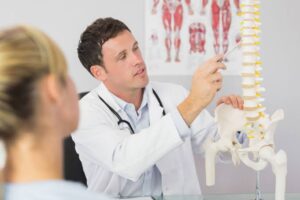Conditions We Treat
 Over 50% of Australians have experienced neck pain at some point in their life. It can present in many ways, from a dull ache to sharp stabbing pain that limits your movements. This can lead to interference with many of your day-to-day activities. If untreated in time, the cause of your neck pain can lead to shoulder pain, headaches, and migraines. This will subsequently result in poor sleep quality which can lead to chronic pain, stress, and general fatigue. Neck pain is ranked the 4th reason for disability in the world. Your chiropractor is able to diagnose the cause of your pain by taking a detailed history, conducting a thorough physical exam and then referring you for medical imaging if needed. Once the diagnosis is reached, a care plan can be tailored to correct the issue and get you your life back.
Over 50% of Australians have experienced neck pain at some point in their life. It can present in many ways, from a dull ache to sharp stabbing pain that limits your movements. This can lead to interference with many of your day-to-day activities. If untreated in time, the cause of your neck pain can lead to shoulder pain, headaches, and migraines. This will subsequently result in poor sleep quality which can lead to chronic pain, stress, and general fatigue. Neck pain is ranked the 4th reason for disability in the world. Your chiropractor is able to diagnose the cause of your pain by taking a detailed history, conducting a thorough physical exam and then referring you for medical imaging if needed. Once the diagnosis is reached, a care plan can be tailored to correct the issue and get you your life back.
 This is considered to be the top reason why people seek chiropractic care. In Australia 90% of people experience lower back pain at some point in their life. There are a number of reasons why you might be experiencing lower back pain and treating it begins with getting the right diagnosis. You may experience it as a simple niggle that you feel after sitting down for long periods of time, a sharp pain when bending forward, a pain down the legs that feels like sciatica or pain after standing for a long time. Each of these presentations arise from different types of injuries whether it’s a disc bulge, facet joint inflammation or vertebral misalignment also known as spondylolisthesis. If left untreated, your injury may result in chronic pain. Your chiropractor is able to diagnose the cause of your pain by taking a detailed history, conducting a thorough physical exam and then referring you for medical imaging if needed. Once the diagnosis is reached, a care plan can be tailored to correct the issue and get you your life back.
This is considered to be the top reason why people seek chiropractic care. In Australia 90% of people experience lower back pain at some point in their life. There are a number of reasons why you might be experiencing lower back pain and treating it begins with getting the right diagnosis. You may experience it as a simple niggle that you feel after sitting down for long periods of time, a sharp pain when bending forward, a pain down the legs that feels like sciatica or pain after standing for a long time. Each of these presentations arise from different types of injuries whether it’s a disc bulge, facet joint inflammation or vertebral misalignment also known as spondylolisthesis. If left untreated, your injury may result in chronic pain. Your chiropractor is able to diagnose the cause of your pain by taking a detailed history, conducting a thorough physical exam and then referring you for medical imaging if needed. Once the diagnosis is reached, a care plan can be tailored to correct the issue and get you your life back.
 Chronic pain is pain that lasts for longer than 12 weeks. The most recent research literature has found that chronic pain occurs due to changes in brain “Neuroplasticity” which is the brains ability to form and re-organise neurological connections within the brain in response to injury. The brain starts to re-wire and becomes accustomed to the pain, resulting in you experiencing the pain even after the injured tissue has completely healed. Research has also shown that chronic pain is linked with mental health issues and poor sleep. The good news is that the changes in the brain can be reversed with the right tailored treatment and rehabilitation plan. This begins with diagnosing the original event that has led to your chronic pain.
Chronic pain is pain that lasts for longer than 12 weeks. The most recent research literature has found that chronic pain occurs due to changes in brain “Neuroplasticity” which is the brains ability to form and re-organise neurological connections within the brain in response to injury. The brain starts to re-wire and becomes accustomed to the pain, resulting in you experiencing the pain even after the injured tissue has completely healed. Research has also shown that chronic pain is linked with mental health issues and poor sleep. The good news is that the changes in the brain can be reversed with the right tailored treatment and rehabilitation plan. This begins with diagnosing the original event that has led to your chronic pain.
 Nerve pain can present as sharp, stabbing/burning pain, numbness, pins and needles or weakness. This occurs when a structure is pressing on the nerve, causing symptoms in the area supplied by that nerve. For example, the nerves exiting the neck supply the shoulders, hands and fingers. If one of these nerves is pinched, you may experience symptoms and nerve pain . However, more than one nerve supplies the same area sometimes. Your chiropractor can identify which nerve is being pinched by taking a detailed history, performing clinical tests and referring you for medical imaging if needed. Once the diagnosis is reached, chiropractic techniques can be used to free up the pinched nerve and improve your symptoms.
Nerve pain can present as sharp, stabbing/burning pain, numbness, pins and needles or weakness. This occurs when a structure is pressing on the nerve, causing symptoms in the area supplied by that nerve. For example, the nerves exiting the neck supply the shoulders, hands and fingers. If one of these nerves is pinched, you may experience symptoms and nerve pain . However, more than one nerve supplies the same area sometimes. Your chiropractor can identify which nerve is being pinched by taking a detailed history, performing clinical tests and referring you for medical imaging if needed. Once the diagnosis is reached, chiropractic techniques can be used to free up the pinched nerve and improve your symptoms.
We have all experience headaches at some point. Headaches can be very frustrating, resulting in you having to put your day on hold. Chiropractic care can help with headaches, but it all starts with finding out what is causing your headache. The first thing to do is to rule out any red flags that may indicate a serious pathology e.g. concussion, intracranial bleeding or a tumour. If a serious pathology is suspected, you will be referred to the appropriate specialist. Headaches can be caused by cervical spine dysfunction, upper back muscular imbalances, jaw dysfunction and a number of other reasons. Once the cause/trigger of your headaches is identified, a tailored treatment and management plan will be designed to help you get your life back.

 Posture is the position in which someone holds their body when standing or sitting. Posture is considered to be the “Window to the Spine”. Postural changes are common in society due to people sitting for long periods of time or looking down at their mobile phone. Poor posture is linked to many aches, pains, and injuries. A recent study has linked poor posture to a decline in cognitive abilities when ageing. Improving your posture can help your breathing, reduce stress on the ligaments and joints, allow your muscles to work more efficiently, and prevent muscle strain and imbalances. A complete postural assessment can be done so that a treatment and management plan can be designed by your chiropractor to correct your posture.
Posture is the position in which someone holds their body when standing or sitting. Posture is considered to be the “Window to the Spine”. Postural changes are common in society due to people sitting for long periods of time or looking down at their mobile phone. Poor posture is linked to many aches, pains, and injuries. A recent study has linked poor posture to a decline in cognitive abilities when ageing. Improving your posture can help your breathing, reduce stress on the ligaments and joints, allow your muscles to work more efficiently, and prevent muscle strain and imbalances. A complete postural assessment can be done so that a treatment and management plan can be designed by your chiropractor to correct your posture.
 Arthritis is a common cause of pain in different age groups. There are many different types of arthritis. Osteoarthritis or degenerative joint disease is a case of “wear and tear” due to the affected joints of the body being under more load than usual. The risk of osteoarthritis increases with age and is more likely to develop in women, especially after 50 years of age. Although the condition is not reversable, chiropractic care helps with reducing pain, increasing function and may help slow the degenerative process down by reducing the load on the affected area.
Arthritis is a common cause of pain in different age groups. There are many different types of arthritis. Osteoarthritis or degenerative joint disease is a case of “wear and tear” due to the affected joints of the body being under more load than usual. The risk of osteoarthritis increases with age and is more likely to develop in women, especially after 50 years of age. Although the condition is not reversable, chiropractic care helps with reducing pain, increasing function and may help slow the degenerative process down by reducing the load on the affected area.
During pregnancy the body releases hormones to relax the ligaments to make the birthing process easier. This means that it is easy for joints in the body to get misaligned which can lead to different aches and pains. Around 50% of women experience pain during pregnancy. Common reasons for women seeing a chiropractor during pregnancy include lower back pain, sciatica, neck and shoulder tension, headaches and pelvis or pubic symphysis pain. Your chiropractor can help by using safe and effective treatment methods from pre conception through to the post natal period.
Baarbé, J., Holmes, M., Murphy, H., Haavik, H. and Murphy, B., 2016. Influence of Subclinical Neck Pain on the Ability to Perform a Mental Rotation Task: A 4-Week Longitudinal Study With a Healthy Control Group Comparison. Journal of Manipulative and Physiological Therapeutics, 39(1), pp.23-30.
Chaibi, A., Knackstedt, H., Tuchin, P. and Russell, M., 2017. Chiropractic spinal manipulative therapy for cervicogenic headache: a single-blinded, placebo, randomized controlled trial. BMC Research Notes, 10(1).
Chaibi, A., Tuchin, P. and Russell, M., 2011. Manual therapies for migraine: a systematic review. The Journal of Headache and Pain, 12(2), pp.127-133.
Haavik, H., Murphy, B. and Kruger, J., 2016. Effect of Spinal Manipulation on Pelvic Floor Functional Changes in Pregnant and Nonpregnant Women: A Preliminary Study. Journal of Manipulative and Physiological Therapeutics, 39(5), pp.339-347.
Shaghayeghfard, B., Ahmadi, A., Maroufi, N. and Sarrafzadeh, J., 2015. Evaluation of forward head posture in sitting and standing positions. European Spine Journal, 25(11), pp.3577-3582.
Vining, R., Long, C., Minkalis, A., Gudavalli, M., Xia, T., Walter, J., Coulter, I. and Goertz, C., 2020. Effects of Chiropractic Care on Strength, Balance, and Endurance in Active-Duty U.S. Military Personnel with Low Back Pain: A Randomized Controlled Trial. The Journal of Alternative and Complementary Medicine, 26(7), pp.592-601
